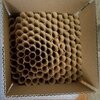KennBarrett
Member
- Joined
- Dec 11, 2020
- Messages
- 16
I have what I believe to be a technical question regarding the patent breech of the .54 cal Lyman Great Plains Rifle. I've made tubes from nitrated cigarette paper containing pre-measured powder amounts, such as 60 gr. & 90 gr. I've appropriately sized the tube diameter just under .54 cal so that it can be conveniently inserted into the muzzle & allowed to drop to the breech. I would then insert a lubed patch & .530 ball with my short starter & complete the loading procedure with my ramrod. I've never had any ignition problems doing this in a muzzleloader with a conventional flat breech. Regardless of whether or not the delicate cigarette paper burst under compression by the patch & ball, it's nitrated & the RWS 1075 #11 percussion cap always does its job. I'm concerned though about doing this in my Lyman because it has a patent breech. In the event the pre-loaded tube doesn't burst, the sparks from the cap should be sufficient for the 2-F powder to ignite. However, would there be a possibility of creating what might instead be perceived as a blockage, thereby causing quite an unintentional reaction?





